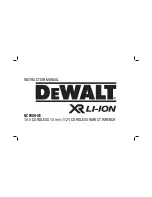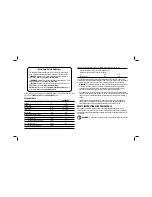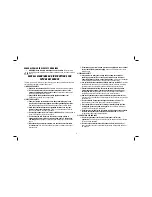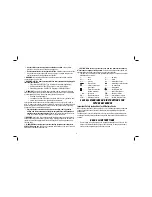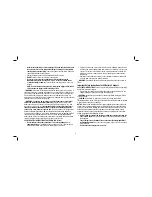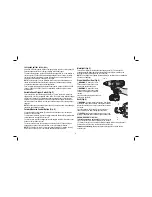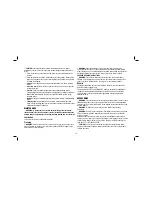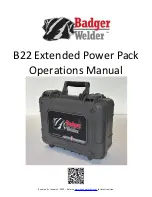
4
CAUTION: When not in use, place tool on its side on a stable surface where it
will not cause a tripping or falling hazard.
Some tools with large battery packs will
stand upright on the battery pack but may be easily knocked over.
• The label on your tool may include the following symbols. The symbols and their
definitions are as follows:
V ................. volts
A ...............amperes
Hz ............... hertz
W ..............watts
min ............. minutes
...........alternating current
........ direct current
...........alternating or direct current
.............. Class I Construction
no ..............no load speed
...................
...................
(grounded) n
................rated
speed
.............. Class II Construction
.............earthing terminal
...................
(double insulated)
..............safety alert symbol
…/min ........ per minute
BPM ..........beats per minute
IPM ............. impacts per minute
RPM ..........revolutions per minute
SPM ............ strokes per minute
sfpm ..........surface feet per minute
SAVE ALL WARNINGS AND INSTRUCTIONS FOR
FUTURE REFERENCE
Important Safety Instructions for All Battery Packs
When ordering replacement battery packs, be sure to include the catalog number and
voltage. Consult the chart at the end of this manual for compatibility of chargers and
battery packs.
The battery pack is not fully charged out of the carton. Before using the battery pack
and charger, read the safety instructions below and then follow charging procedures
outlined.
READ ALL INSTRUCTIONS
• Do not charge or use the battery pack in explosive atmospheres, such as in the
presence of flammable liquids, gases or dust. Inserting or removing the battery
pack from the charger may ignite the dust or fumes.
•
Air vents often cover moving parts and should be avoided.
Loose clothes,
jewellery or long hair can be caught in moving parts.
•
Do not operate this tool for long periods of time.
Vibration caused by tool action
may be harmful to your hands and arms. Use gloves to provide extra cushion
and limit exposure by taking frequent rest periods.
WARNING:
We recommend the use of a residual current device with a residual
current rating of 30mA or less.
WARNING: ALWAYS wear approved protective safety equipment complying with
the following standards:
• Eye protection: AS/NZS1337 Eye Protectors for Industrial Applications;
• Hearing protection: AS/NZS1270 Acoustics – Hearing Protection;
• Respiratory protection: AS/NZS1716 Respiratory Protective Devices.
WARNING:
Some dust created by power sanding, sawing, grinding, drilling, and
other construction activities contains chemicals known to cause cancer, birth defects
or other reproductive harm. Some examples of these chemicals are:
• lead from lead-based paints,
• crystalline silica from bricks and cement and other masonry products, and
• arsenic and chromium from chemically-treated lumber.
Your risk from these exposures varies, depending on how often you do this type of
work. To reduce your exposure to these chemicals: work in a well ventilated area, and
work with approved safety equipment, such as those dust masks that are specially
designed to filter out microscopic particles.
•
Avoid prolonged contact with dust from power sanding, sawing, grinding,
drilling, and other construction activities. Wear protective clothing and wash
exposed areas with soap and water.
Allowing dust to get into your mouth, eyes,
or lay on the skin may promote absorption of harmful chemicals.
WARNING:
Use of this tool can generate and/or disburse dust, which may cause
serious and permanent respiratory or other injury. Always use approved AS/NZS1716
respiratory protection appropriate for the dust exposure. Direct particles away from
face and body.
WARNING: Always wear proper personal hearing protection that conforms to
AS/NZS1270 during use.
Under some conditions and duration of use, noise from this
product may contribute to hearing loss.
Summary of Contents for DCF889-XE
Page 1: ...DCF889 XE 18 V CORDLESS 13 mm 1 2 CORDLESS IMPACT WRENCH INSTRUCTION MANUAL ...
Page 2: ......
Page 13: ......
Page 14: ......
Page 15: ......

